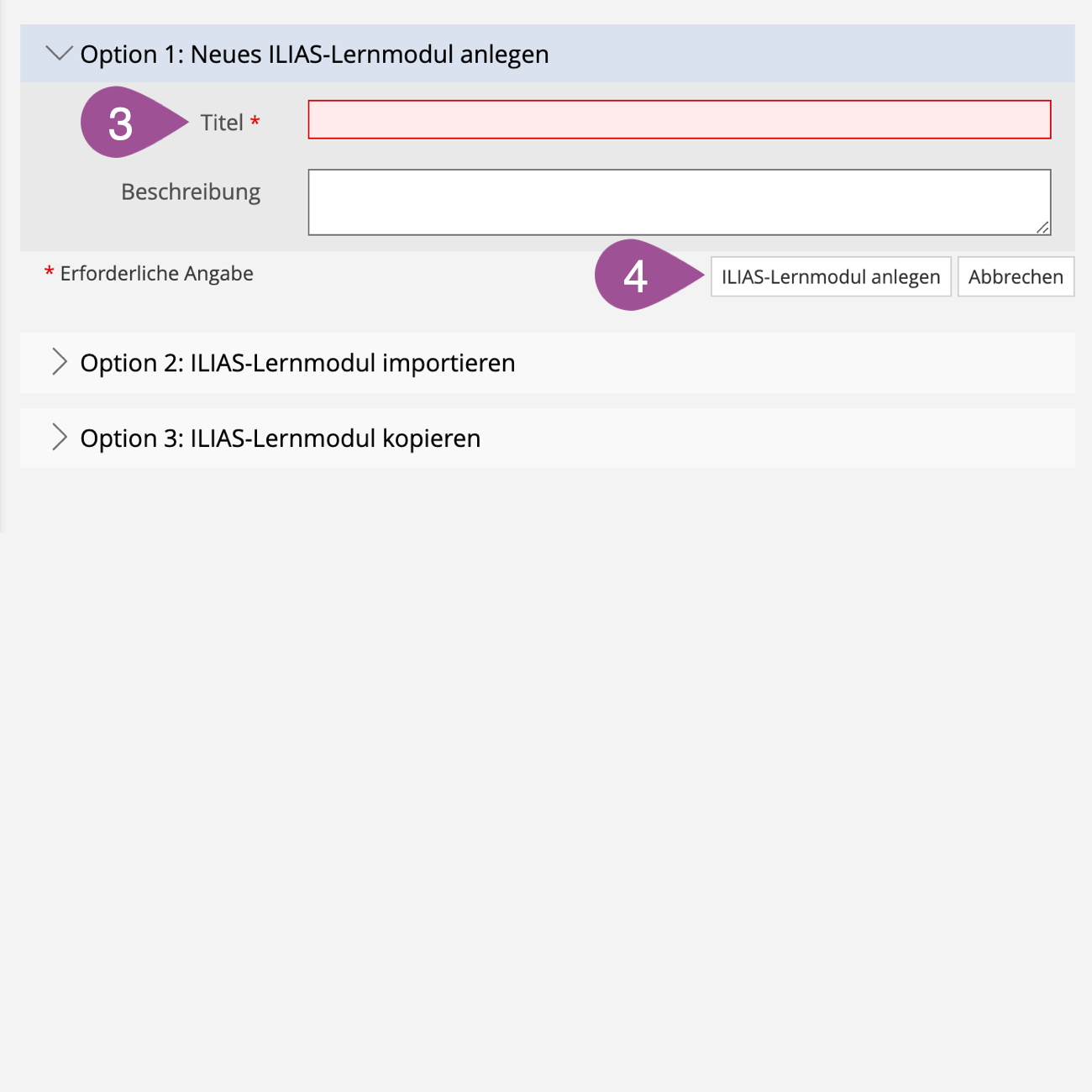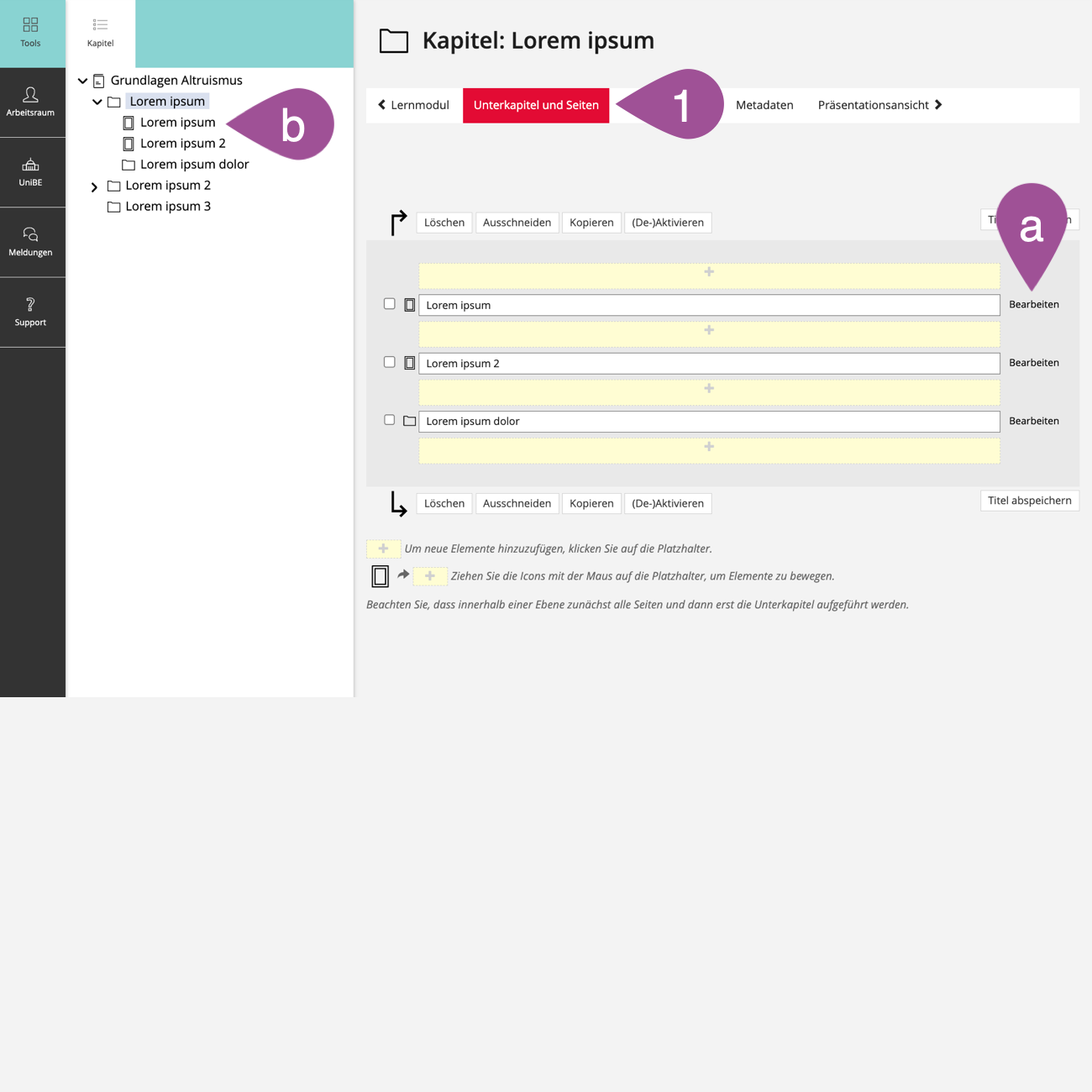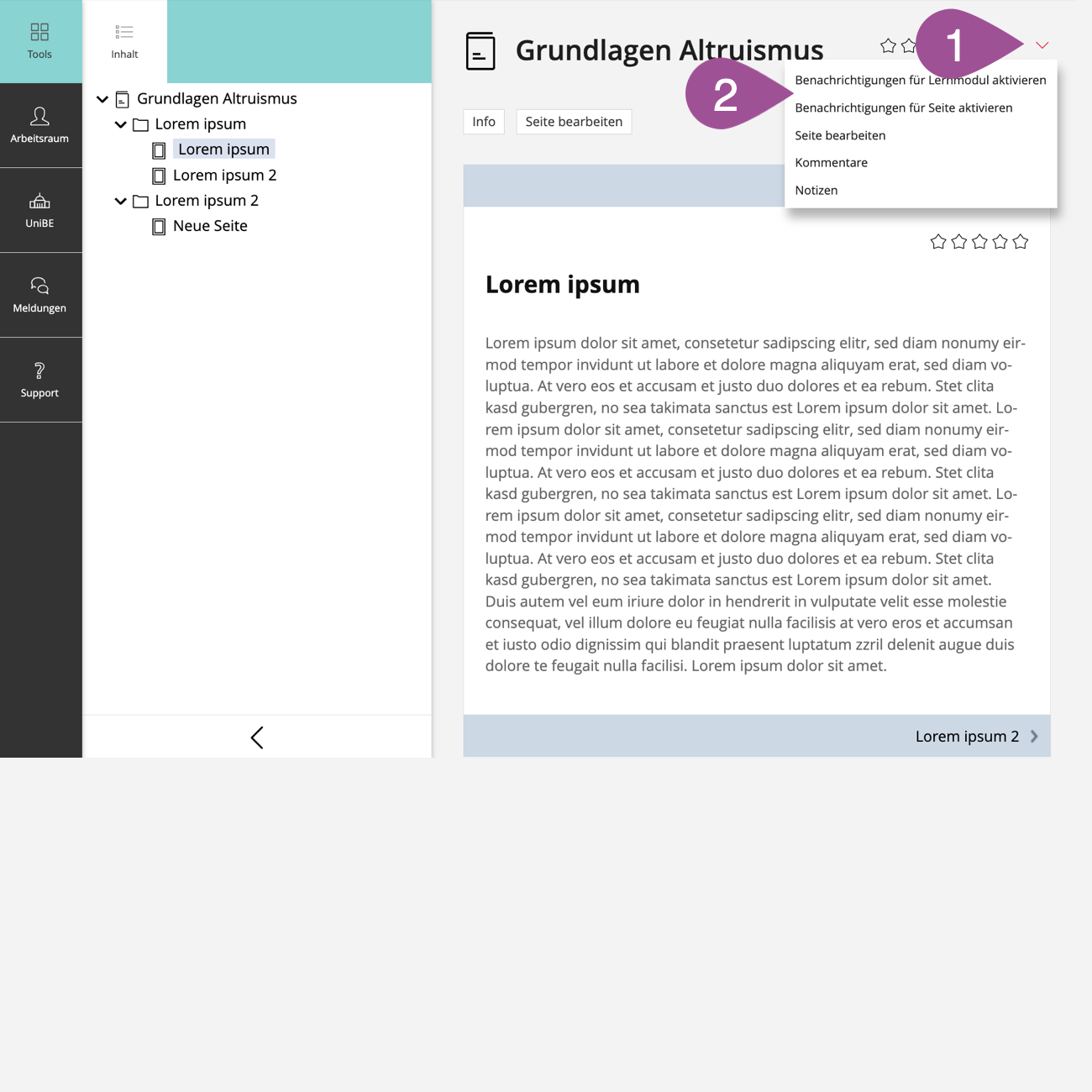ILIAS Support (English)
Reiter
Manual: Learning Module
Deutsch | English
Manual: Learning Module

1. Create a learning module
2. Switch between preview mode & edit mode
3. Adjust settings
3.1 Configure basic settings
3.2 Link a learning module with a glossary
4. Add contents
4.1 Create chapters
4.2 Create subchapters & pages
4.3 Add learning content
5. Enable & disable notifications
6. Create a learning module with external editors
7. Application scenarios
.
1. Create a learning module
Click on «Add New Item». | |
Select «Learning Module ILIAS». | |
Give the learning module a «Title». | |
Click on «Add ILIAS Learning Module». |
.
2. Switch between preview mode & edit mode
When you open a learning module, e.g., from a course room directly or via a link, you enter the preview mode, which displays the current page.
To edit settings and permissions and create and manage chapters and pages, you have to switch to edit mode. Follow the steps below to do so:
In preview mode, click on «Edit Page». | |
Click on «Chapters». | |
In the tree view, click the title of the learning module. You will be redirected to the edit mode of the learning module. | |
To access the settings and permissions of the learning module, switch to the corresponding tab. You may have to switch to the «Learning Module» section first. | |
To return to preview mode, click on «Presentation View». |
.
3. Adjust settings
.
Configure basic settings
.
Availability
In edit mode, go to the «Settings» tab. | |
The learning module has to be «online» to be visible and usable for others. | |
«Save» your settings. |
You can set the period in which the learning module can be accessed. Outside this period, the learning module cannot be accessed.
Go to the location on ILIAS where you have stored the learning module. | |
Open the learning module's actions menu. | |
Select «Availability». | |
Activate the «Temporarily available» option and enter the period during which you want the learning module to be accessible. | |
If checked, the learning module is visible outside the designated availability but cannot be accessed. | |
«Save» your settings. |
.
Presentation
In edit mode, go to the «Settings» tab. | |
Under «Tile Image» you can upload a tile image for the learning module (see also Manual: Tile design). When inserting images, please follow the recommended image sizes. Notes on image sizes on ILIAS | |
You can choose what the page headers should be based on. This setting also affects what appears in the tree structure under «Content». For the «Chapter Title» option, the included pages are labeled with a page index (e.g., 2/3). | |
If checked, chapters will be numbered automatically. | |
Choose which items you want to be displayed in the table of contents. The table of contents is only displayed in preview mode if the learning module contains at least two pages. | |
If checked, a progress icon is displayed instead of the chapter and page icons in the table of contents. | |
«Save» your settings. |
.
Self Assessment
In a learning module, you can insert one or more questions with feedback on each page (see 4.3 Add learning content), which students can use to check whether they have understood the content. In the «Self Assessment» section in the Settings, you can specify the general properties of these questions.
In edit mode, go to the «Settings» tab. | |
Select whether questions that have already been answered have to be answered again when returning to the page or whether they will be skipped. | |
If checked, subsequent pages in the learning module will not be accessible until all questions are answered correctly. | |
If checked, no default feedback is presented after answering questions.
If you do not define your own feedback for your questions (see 4.3 Add learning content), you should keep the default feedback activated. If you provide your own feedback for each question, you can deactivate the default feedback option. Otherwise, your own feedback will be added to the default feedback. | |
«Save» your settings. |
.
Additional Features
In edit mode, go to the «Settings» tab. | |
If checked, users can add comments to all pages of the learning module. | |
*Text (HINWEIS) | If checked, a comment field is provided in the pages' edit mode. Comments created here can be viewed by administrators in the «History» sub-tab of the «Content» tab. |
If checked, users can rate the learning module as a whole. | |
If checked, users can rate pages of the learning module individually. | |
«Save» your settings. |
.
Link a learning module with a glossary
If a glossary (see Description content items and Manual: Glossary) is linked to a learning module, terms from the glossary are automatically highlighted and linked in the text of the learning module. When you click on a linked term, the term definition stored in the glossary is displayed directly in the learning module.
In edit mode, go to the «Settings» tab and then to the «Glossaries» sub-tab. | |
Click on «Add». | |
Click on the corresponding glossary in the tree view. Confirm your selection by clicking «Yes». | |
The linked glossary is now listed in the «Glossaries» sub-tab. |
.
4. Add contents
To add content to learning modules, you first create individual «Chapters». In these chapters, you then create «Pages» where you place the learning content in a final step. Please note that students can only access pages that are assigned to a chapter.
.
Create chapters
In edit mode, go to the «Content» tab (see 2. Switch between preview mode & edit mode). | |
Click on the bar with the plus sign and choose how many chapters you want to insert. You can create up to 10 chapters at a time. | |
Give each chapter a «Title». | |
Click «Save Titles». Whether this title is displayed in the learning module depends on the settings of the learning module (see 3. Adjust settings). |
.
Create subchapters & pages
Subchapters and pages are created within a chapter in the «Subchapters and Pages» tab. You have two options:
| |||||
Click on the bar with the plus sign and choose how many chapters you want to insert. You can create up to 10 subchapters or 10 pages at a time. | |||||
Give each subchapter and each page a «Title». Whether this title is displayed in the learning module depends on the settings of the learning module (see 3. Adjust settings). | |||||
Click «Save Titles». |
.
Add learning content
Learning contents are added to a page in the «Subchapters and Pages» tab. You have two options:
This opens the page editor, with which you can add content to the page (see Manual: Page Editor). | |||||
If you want to add self-assessment questions to your page, you can do so using the «Insert Question» option.
|
.
5. Enable & disable notifications
You can be notified about changes in a learning module via ILIAS emails.
In preview mode, open the learning module's actions menu. | |
Choose whether you want to enable or disable notifications for the current page only or for the entire learning module. |
.
6. Create a learning module with external editors
ILIAS also allows you to create learning modules with external editors (HTML, SCORM). To do so, select the option «Learning module HTML» die Option or «Learning module SCORM» from the «Add New Item» menu.
For HTML learning modules, you will be prompted to specify a start file. Ideally, you prepare your HTML learning materials in a folder. This folder can be uploaded to ILIAS as a zip archive. After unzipping the archive, you can now specify the start file by opening the file's actions menu and clicking on «Set Start File».
For an error-free import of a web page into ILIAS, please ensure that all HTML pages linked to each other contain only relative links in the form (bilder/foo.jpg or .../verz1/datei.html).
.
7. Application scenarios
The following pages will give you an idea of how a learning module can be used:
Zuletzt geändert: 5. Sep 2025, 07:26, Thiel, Anja [a.thiel5]































